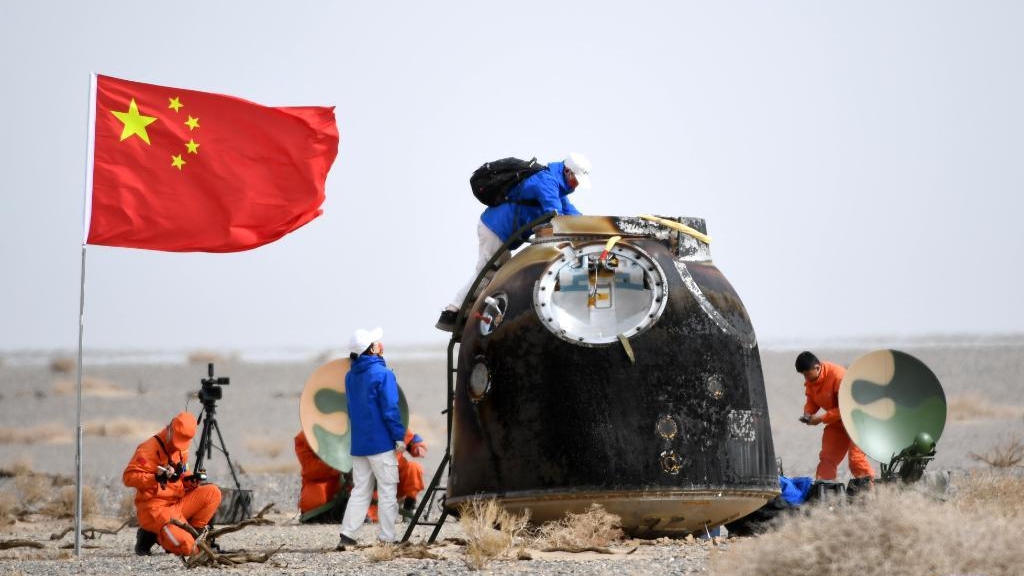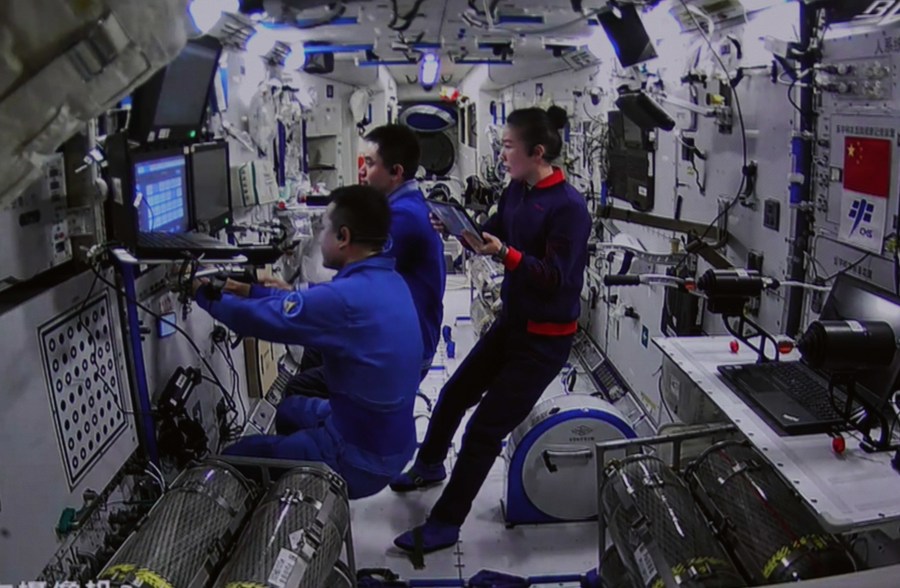
The return capsule of the Shenzhou-13 manned spaceship lands successfully at the Dongfeng landing site in north China's Inner Mongolia Autonomous Region, April 16, 2022. /Xinhua
The return capsule of the Shenzhou-13 manned spaceship lands successfully at the Dongfeng landing site in north China's Inner Mongolia Autonomous Region, April 16, 2022. /Xinhua
Editor's note: Marsha Freeman is the technology editor of Executive Intelligence Review magazine and the author of several books on space including, "How We Got To the Moon: The Story of the German Space Pioneers." The article reflects the author's views, and not necessarily those of CGTN.
The return of the record-setting Shenzhou-13 on April 16 ended a six-month stay in space with a three-person crew. One major goal was to prepare the station for future groups of taikonauts who will complete the assembly of the space station. This is scheduled to be completed by the end of this year.
Thanks to a new quick return procedure deployed for the first time, Shenzhou-13's return trip lasted about nine hours rather than the 24-hour trip for its predecessors, with the return capsule only circling the Earth five times before entering its final return orbit instead of 11 times as in past missions.
The rocket for the next launch of a supply ship to the station is already at the Wenchang Space Launch Center. An additional supply ship and two more crewed missions are needed to complete the station. When Shenzhou-15 arrives at the station, the three taikonauts from the previous Shenzhou-14 mission will still be on the station, and there will be a handover to the new team.
The Shenzhou-13 crew was responsible for unpacking some of the science instruments to be used for experiments on the station. They also performed two spacewalks, conducted more than 20 different science experiments in addition to delivering two live educational lectures.
During the first spacewalk, they installed the robotic arms suspension and adapter and also tested the equipment. On the second spacewalk, they deployed an external "panoramic camera", installed a foot restraint platform, and tested various methods of moving objects outside the station with the space arm.
Taikonaut Wang Yaping, who gave the first public class from the Tiangong-1 space station, gave two such classes on this trip to Tiangong-2, which were viewed by millions of school children in China. In addition, the taikonauts Zhai Zhigang, Wang Yaping and Ye Guangfu were sent questions from 20 schools in 13 U.S. states by American school children. The pre-recorded questions and responses were shared with students, parents and teachers at a "My Questions to Taikonauts" event on April 9 sponsored by the Chinese Embassy in Washington, D.C. Over 300 American students watched the event on-line.
This was the first six-month mission, which will give those on the ground the opportunity to study the effects of the longer duration mission on the taikonauts, especially on the ageing process. The six-month stay will become the norm for crews in the future.

Screen image taken at Beijing Aerospace Control Center shows the Shenzhou-13 astronauts in China's space station core module conducting the manual rendezvous and docking experiment with the Tianzhou-2 cargo craft, January 8, 2022. /Xinhua
Screen image taken at Beijing Aerospace Control Center shows the Shenzhou-13 astronauts in China's space station core module conducting the manual rendezvous and docking experiment with the Tianzhou-2 cargo craft, January 8, 2022. /Xinhua
Visiting the Wenchang Space Launch Center on April 15, Chinese President Xi Jinping said that the facility serves China's new-generation, heavy-lift carrier rockets and plays a significant role in the country's deep-space exploration endeavors. The Chinese President called for efforts to attain "world-leading standards" for China's spacecraft launch facilities.
The space station is presently at the center of China's space exploration efforts. Space exploration in turn is at the center of China's science and technology thrust. As was shown in its day, the Apollo program gave the United States a scientific boost which created innovation for two decades. Space became the "science driver" for the U.S. economy through the 1980s and 90s. The Apollo program, however, ended in 1972, and U.S. human space exploration has remained in low-Earth orbit since then.
China, on the other hand has a 30-year program of development in space. The space station is the first step in what is a more extensive Chinese program for further space exploration. The space station has already created tremendous excitement among young people in China.
More importantly, the Chinese space station remains the only project in lower Earth orbit that is open to all countries. This is particularly the case for developing countries with limited opportunity otherwise to participate in space exploration.
China has welcomed African scientists to visit and participate in its space experiments and technology building, transferring hands-on knowledge to beneficiaries. China has also helped build and launch satellites for Nigeria, Algeria, Sudan and Ethiopia.
With the limitations on participation in the International Space Station and the more restrictive nature of future participation in U.S. programs for "geopolitical" reasons, the Chinese Space Station remains the only option for unrestricted access by all countries, and China has announced that with its completion, there will also be foreign astronauts on the Tiangong-2 as well as on the planned China-Russia International Lunar Research Station. In that respect, China is remaining true to the initial hopes for space exploration that it remains one of the common aims of mankind.
(If you want to contribute and have specific expertise, please contact us at opinions@cgtn.com. Follow @thouse_opinions on Twitter to discover the latest commentaries on CGTN Opinion Section.)

